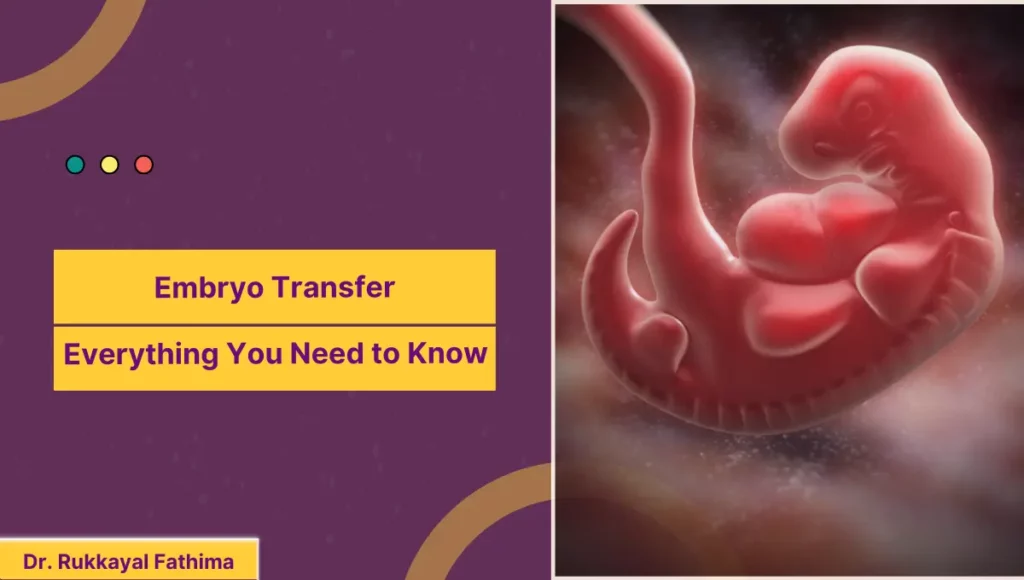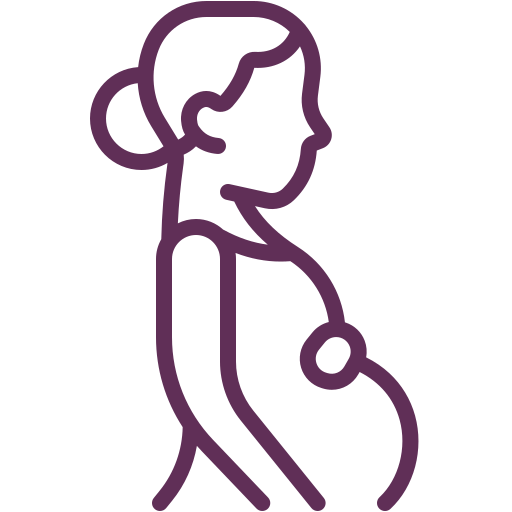Embryo transfer is the last and most important step of the IVF procedure. This is where the fertilised embryos are transferred into the uterus for further development. There are some things that patients should take note of before, during and after the embryo process. This article gives a detailed explanation of everything one needs to know about embryo transfers.
What is an embryo transfer?
Embryo transfer is the final stage of In Vitro Fertilisation, where the Fertilised eggs are transferred back into the uterus of the female so that they can implant and result in pregnancy.
The embryo transfer is an important step in IVF treatment that determines the success of the process. Implantation of the embryos must be precise, so it is usually done with the help of an ultrasound scan.
Types of embryo transfer
There are two ways embryo transfer can be done. They are fresh embryo transfer and frozen embryo transfer.
- Fresh embryo transfer is where eggs are fertilised and transferred into the uterus within 5 days of egg retrieval.
- Frozen embryo transfer is when embryos are frozen and transferred into the uterus 1 or 2 months after egg retrieval.
Fresh embryo transfer
As the name implies, fresh embryo transfers are done within three to five days of egg retrieval. Once the eggs are retrieved and fertilised in a laboratory, they are monitored to determine which embryos have the best chance of pregnancy and their level of development.
Based on the development of the embryos, they can be transferred back into the uterus on the third and fifth day of egg retrieval.
Day 3 (Cleavage) embryo transfer
Also called Cleavage embryo transfer, these embryos are transferred when their cells are in the process of cleaving or dividing. The changes happen only in the cells, and the embryos don’t grow in size. Most embryos reach this stage on day 3, but they may also occur on day 2 or 4.
Day 5 (Blastocyst) embryo transfer
Also called Blastocyst embryo transfer, these embryos are transferred when they have developed into a single-layered sphere of 60 to 120 cells encircling a fluid-filled cavity. Transferring an embryo in the blastocyst stage is often considered a better option than the ones in the Cleavage stage (day 3).
Benefits of fresh embryo transfer
- Faster conception. This is a great option for couples who wish to have their baby sooner.
- Cryopreservation techniques are often not covered by insurance. So couples can choose fresh embryo transfer for financial reasons.
Frozen embryo transfer
The initial process is the same for both fresh and frozen embryo transfer. But while fresh embryos are transferred within 5 days of egg retrieval, frozen embryos are frozen using a technique called cryopreservation.
In this cryopreservation process, the embryos are kept viable, but in a stasis state so they can be thawed and used later.
Benefits of using frozen embryos
- Less medication. Frozen embryo transfer (FET) involves taking less medication than fresh embryo transfer. There will still be medication during embryo transfer, but ovary-stimulating medications can be avoided.
- No doubts if the embryos are of good quality. If an embryo is selected to be frozen, it can be seen that the embryos are healthy without any problems.
- Store embryos and use them later. With frozen embryo transfer, you can choose to delay your pregnancy.
The process of embryo transfer
Embryo transfer is the final stage of In Vitro Fertilisation. Before conducting embryo transfer, the best eggs with higher chances of pregnancy will be chosen by the embryologists to be implanted in the uterus.
There are many non-invasive processes that can help select the best embryos, like PGT-A (Preimplantation Genetic Testing for Aneuploidy) and PGD (Preimplantation Genetic Diagnosis). If more eggs are found to be of good quality, the remaining eggs can be frozen for future use.
During embryo transfer
The embryo is collected in a tube and passed through the catheter into the female’s uterus. The embryos are then placed in the uterus for implantation.
This process is minimally painful and does not require many sedatives. Inserting the speculum through the vagine or having a full bladder during the process may discomfort some women. Besides that, the whole process takes a short time and is not much painful.
After embryo transfer
If there are no symptoms after embryo transfer Patients should go for a follow-up treatment to check whether the embryo has implanted in the uterus. Women may experience some side effects like cramping, bloating, and vaginal discharge.
Patients must follow some safety precautions advised by their fertility doctor to ensure the embryo stays safe and healthy in the uterus. Below are some precautions they can follow after embryo transfer.
- Patients can walk to their rooms 15 minutes to half an hour after the embryo transfer.
- Patients can leave home for 3 to 4 hours. They can’t drive, so they must travel with someone else.
- Climbing the stairs is not a problem, but not too often.
- Patients can do their routine work. There is no need for a complete rest.
- Patients should avoid strenuous exercise.
- Hot water baths (bubble baths) should be avoided.
And finally, patients should take all the medicines prescribed by the doctor on time and have a stress-free and healthy atmosphere.
How many embryos are transferred?
The number of embryos transferred varies according to the age and outlook of the female. In most cases, fertility doctors only transfer one embryo into the uterus. But some doctors believe that transferring two embryos can increase the chances of a successful pregnancy.
Based on the number of embryos transferred, the process can be classified into
- SET/eSET (Single Embryo Transfer / Elective Single Embryo Transfer), and
- Multiple Embryo Transfer
SET/eSET (Single Embryo Transfer)
SET/eSET is the process of transferring a single embryo with the highest chances of pregnancy into the woman’s uterus.
Multiple Embryo Transfer
This is the process where more than one embryo is transferred into the uterus at the same time. This method is not usually used and is only done when the female’s chances of pregnancy are low.
Success rates of embryo transfers
Based on the transfer method used (fresh & frozen), the success rate of embryo transfer varies. There is no statistical difference between using fresh and frozen embryos.
The patient can choose whether they want fresh or frozen embryo transfer. Studies have proved that frozen embryo transfer has a 15-20% increase in success rate than fresh embryo transfer. So most fertility centers prefer frozen embryo transfer.
In addition, frozen embryos can be used for future embryo transfers where fresh embryos cannot. If the chances for pregnancy are low, doctors can use the additional frozen embryos for a second attempt at embryo transfer. To make your Embryo transfer success be aware of your regular food cycle.
Risks and precautions of embryo transfers
There are not any serious risks involved in embryo transfer. Women may experience some minor side effects after the process. Some of them are
- Bloating,
- Abdominal pain,
- Constipation,
- Cramping,
- Tender breasts (due to high estrogen levels),
- Rapid weight gain, and
- Low blood pressure.
Some of the risks involved in unsuccessful embryo transfers are
- Multiple births: This is where more than one embryo implants in the uterus. It may lead to premature labour and low birth weight of the newborn.
- Miscarriage: Even though the rate of miscarriages in IVF is the same as that of unassisted pregnancies, there are more chances of miscarriage with the increase in maternal age.
- Premature delivery: Women may be at slightly more risk of having a premature delivery or having babies with lower birth weight.
- Ectopic pregnancy: This is the condition where the fertilised embryos implant themselves outside the uterus, e.g., the fallopian tubes.
- Ovarian Hyperstimulation Syndrome (OHSS): OHSS is a rare condition that causes nausea, vomiting, abdominal pain, diarrhoea, bloating, rapid weight gain, and the inability to urinate in women.
Conclusion
Embryo transfer is the last and most important step of In Vitro Fertilisation. This step is where the success and failure of the IVF treatment are determined.
Even though this step is crucial, patients don’t need to worry much because they will be cared for and guided every step of the way by their IVF doctors and embryologists.
Frequently asked questions
You can do a pregnancy test about 9 to 14 days after embryo transfer. You can visit your fertility doctor and do a checkup to see if the IVF treatment was a success.
The IVF process, as a whole, is not painful, though patients may experience slight discomfort or mild side effects during the medication, egg retrieval, and embryo transfer procedures.
IVF pregnancies are not considered high-risk unless the parent has an existing health condition or other factors that can weaken their body. For example, advanced maternal age, high blood pressure, or multiple births can be possible risk factors for the parent.
Women have the best chances of getting pregnant when they are in their 20s. This is the age when their body will produce a large number of healthy eggs.





